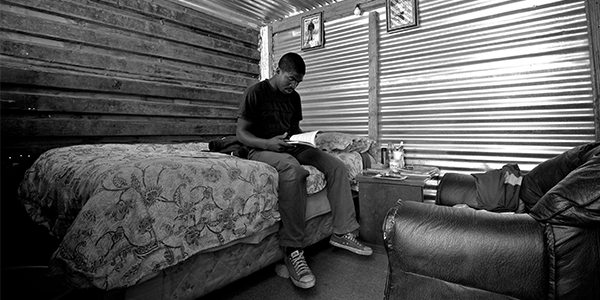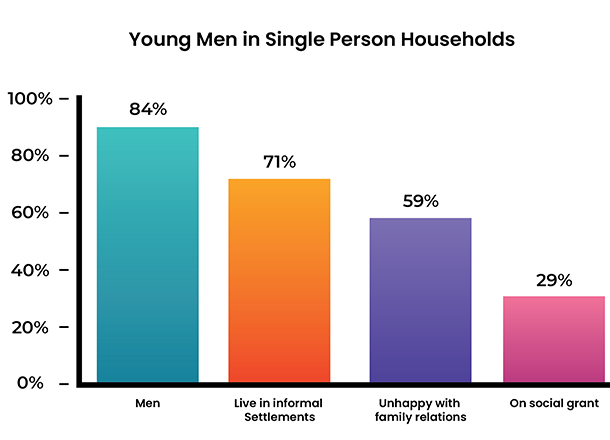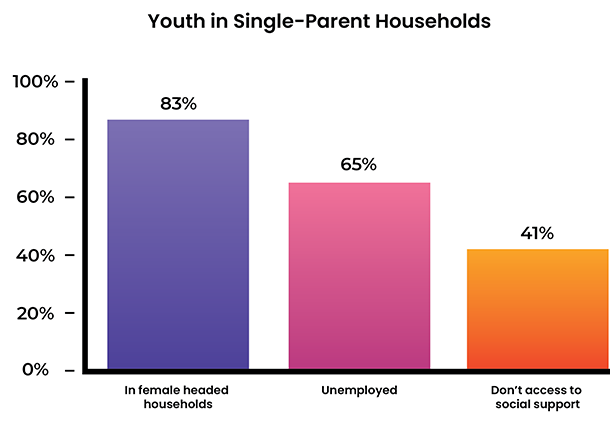We need to do better for our youth
- Prof. Frikkie Booysen
Approximately 51% of the youth from poorer households in Gauteng are not satisfied with their life, and 39% report feeling alienated.

[Picture credit: GCRO - Mike Rasonto]
On the occasion of Youth Month, Professor Frikkie Booysen, the Wits/PPS Chair in Health Economics at the Wits School of Economics and Finance, profiles factors that remain a stark reality for many youth from low socio-economic backgrounds. He draws on data from the 7th Gauteng Quality of Life Survey conducted by the Gauteng City-Region Observatory (GCRO) in 2023/24. Of the 13,795 respondents in the survey, 5,277 were ‘youth’ (18-35 years).
According to Booysen, living arrangements in a household are a critical determinant of family health. In Gauteng, a substantial proportion of the youth in poorer households live in two relatively precarious living arrangements.
Youth living Alone and the lack of social support
The study found that 31% of the youth respondents live alone in what is called single-person households. Young men make up 84% of these respondents and 71% live in informal settlements.
These young men also reported low satisfaction with the time they spend with their families. About 59% were not satisfied with the extent to which they get along with their family, can confide in their family, and can share their feelings with their family.

These young men, as expected, also often find themselves isolated from their networks of social support. In fact, as many as 28% of these young men reported being unable to access social support in the event of an emergency. Further exacerbating this situation is the fact that poor young men living alone generally also find themselves outside of the reach of the safety-net of the social protection programme, with only 29% reporting receiving a social grant.
Regrettably, moreover, living in communities considered unsafe, this also often leaves many of these young vulnerable men, many of whom have grown up in families and communities where violence is not uncommon, susceptible to involvement in gangs. As a result, services that link these young men with family preservation and family strengthening programmes are critical. So too, policymakers are required to consider expanding the reach of social protection, potentially in the form of a universal basic income grant.
Youth living in Single-Parent Female-Headed Households
Nineteen percent report living in single-parent households of which 83% are female-headed. Many youth living in single-parent female-headed households face the adversity of growing up with absent fathers, not to mention the reality of having to take on caregiving duties in the absence of their mothers working to secure their livelihood, often from a young age. It is not surprising but very concerning that 41 % of these youth report having no access to social support in the event of an emergency. At 65%, the considerably high rate of unemployment among these youth renders them economically marginalised, the effects of which are likely to multiply many times over their lifetimes and that of their children. To address this grave situation, job creation initiatives targeting women and youth should be accelerated.

Despite these youth being important to target given these stark realities, it is equally important to highlight the precarious living circumstances of most youth from poorer communities. For starters, the high national youth unemployment rate, currently at 46 percent, is testimony to more than half of the youth in poor households having failed to complete grade 12, severely hampering these youth’s prospects to further advance their education or employment prospects. To be factual, picture a world in which 44 %of the poor still live in circumstances where their household often goes hungry, where 60 %of their neighbours still live mainly from hand-to-mouth, and where 65 %of their neighbours has little prospect of getting ahead in life. This reality goes some way toward explaining why 51% of the youth from poorer households in Gauteng are not satisfied with their life, 19 %are at an elevated risk of depression, and 39 % report feeling alienated, thus signalling the critical role of scaling up youth empowerment programmes that have proven effective.
We, as scientists, are therefore obligated to the youth, not only in this month but beyond, to prioritise research that informs evidence on how policies and programmes may leverage families’ protective role in harnessing the youth’s health and well-being for their emancipation. An example of such effort is Professor Booysen’s recently initiated community-based collaboration with Westbury Youth Centre and the Innovation Zones programme at Queen’s University Belfast (CUB).

